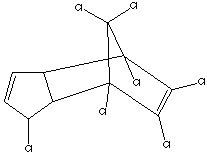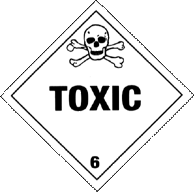Heptachlor
- 1,4,5,6,7,8,8-Heptachloro-3a,4,7,7a-tetrahydro-4,7-methanoindene
- 1,4,5,6,7,8,8-Heptachloro-3a,4,7,7a-tetrahydro-4,7-methano-1H-indene

Heptachlor | |
| |
| Formula | C10H5Cl7 |
| Structure |  |
| Description | A white to light tan waxy looking solid. |
| Uses | Insecticide for control of cotton boll weevil - former use. |
| Registry Numbers and Inventories. | |
| CAS | 76-44-8 |
| EC (EINECS/ELINCS) | 200-962-3 |
| EC Index Number | 602-046-00-2 |
| EC Class | Toxic; Carcinogenic Category 3; Danger of cumulative effects; Dangerous for the Environment |
| RTECS | PC0700000 |
| RTECS class | Agricultural Chemical and Pesticide; Tumorigen; Mutagen; Reproductive Effector |
| UN (DOT) | 2761 |
| Merck | 12,4690 |
| Beilstein/Gmelin | 2058523 |
| RCRA | P059 |
| EPA OPP | 44801 |
| Swiss Giftliste 1 | G-1675 |
| Austrailia AICS | Listed |
| Japan ENCS (MITI) | Listed |
| Properties. | |
| Formula | C10H5Cl7 |
| Formula mass | 373.32 |
| Melting point, °C | 46 - 47 |
| Boiling point, °C | 392 |
| Vapor pressure, mmHg | 0.000233 (25 C) |
| Density | 1.66 g/cm3 (20 C) |
| Solubility in water | Insoluble |
| Partition coefficient, pKow | 5.44 |
| Heat of vaporization | 61.7 kJ/mol |
| Hazards and Protection. | |
| Storage | Keep in well ventilated area. Protect containers against physical damage. Outdoor or detached storage preferred. In case of indoor storage, cool, well-ventilated, fire-proof place should be used and kept away from source of ignition. |
| Handling | All chemicals should be considered hazardous. Avoid direct physical contact. Use appropriate, approved safety equipment. Untrained individuals should not handle this chemical or its container. Handling should occur in a chemical fume hood. |
| Protection | Wear appropriate protective gloves, clothing and goggles. |
| Respirators | Wear positive pressure self-contained breathing apparatus (SCBA). |
| Small spills/leaks | Keep material out of water sources and sewers. Build dikes to contain flow as necessary. Land spill: Dig a pit, pond, lagoon, holding area to contain liquid or solid material. Cover solids with a plastic sheet to prevent dissolving in rain or fire fighting water. Water spill: Use natural deep water pockets, excavated lagoons, or sand bag barriers to trap material at bottom. If dissolved, in region of 10 ppm or greater concentration, apply activated carbon at ten times the spilled amount. Remove trapped material with suction hoses. Use mechanical dredges or lifts to remove immobilized masses of pollutants and precipitates. |
| Stability | Stable. |
| Incompatibilities | Incompatible with strong alkali It is |
| Decomposition | Decomposition products: toxic gases and vapors which include: hydrogen chloride and carbon monoxide. |
| Fire. | ||||
| Flash Point,°C | 192 | |||
| Fire fighting | Extinguish fire using agent suitable for type of surrounding fire. (Material itself does not burn or burns with difficulty.) Use water in flooding quantities as fog. Use foam, dry chemical, or carbon dioxide. If large quantities of combustibles are involved, use water in flooding quantities as spray and fog. | |||
| Fire potential | Nonflammable. | |||
| Combustion products | Irritating hydrogen chloride fumes may form in fire. | |||
| Health. | |
| Exposure limit(s) | TLV: 0.05 mg/m3 (as TWA), A3 (skin) (ACGIH 1997). OSHA PEL: TWA 0.5 mg/m3 skin NIOSH REL: Ca TWA 0.5 mg/m3 skin See Appendix A NIOSH IDLH: Potential occupational carcinogen 35 mg/m3 |
| Carcinogin | G-A3, I-2B, CP65 |
| Poison_Class | 2 |
| Exposure effects | CNS excitation, seizures, tremor, ataxia, agitation, nervousness, and amnesia may occur. Kelthane, perthane, methoxychlor, and hexachlorobenzene have little CNS toxicity; in extreme overdose CNS depression may occur. Organochlorine pesticides such as DDT pass through the placenta, with an average level in the newborn blood reaching around a third of that in maternal blood. They can also be found in breast milk. Excessive absorption of kepone (chlordecone) has depressed sperm counts and sperm motility in exposed workers. |
| Ingestion | Nausea, vomiting, and diarrhea may follow ingestion. |
| Inhalation | Aspiration of insecticide containing petroleum distillate may result in pneumonitis. |
| Skin | Extensive contact results in dermal irritation. |
| Eyes | See Inhalation. |
First aid |
|
| Ingestion | If the victim is conscious and not convulsing, give 1 or 2 glasses of water to dilute the chemical and IMMEDIATELY call a hospital or poison control center. MMEDIATELY transport the victim to a hospital. |
| Inhalation | IMMEDIATELY leave the contaminated area; take deep breaths of fresh air. IMMEDIATELY call a physician and be prepared to transport the victim to a hospital even if no symptoms (such as wheezing, coughing, shortness of breath, or burning in the mouth, throat, or chest) develop. Provide proper respiratory protection to rescuers entering an unknown atmosphere. Whenever possible, Self-Contained Breathing Apparatus (SCBA) should be used. |
| Skin | IMMEDIATELY flood affected skin with water while removing and isolating all contaminated clothing. Gently wash all affected skin areas thoroughly with soap and water. IMMEDIATELY call a hospital or poison control center even if no symptoms (such as redness or irritation) develop. IMMEDIATELY transport the victim to a hospital for treatment after washing the affected areas. |
| Eyes | First check the victim for contact lenses and remove if present. Flush victim's eyes with water or normal saline solution for 20 to 30 minutes while simultaneously calling a hospital or poison control center. Do not put any ointments, oils, or medication in the victim's eyes without specific instructions from a physician. IMMEDIATELY transport the victim after flushing eyes to a hospital even if no symptoms (such as redness or irritation) develop. |
| Transport. | ||
| UN number | 2761 |  |
| Response guide | 151 | |
| Hazard class | 6.1 | |
| Packing Group | I; II; III | |
| USCG CHRIS Code | HTC | |
| Std. Transport # | 4960630 | |